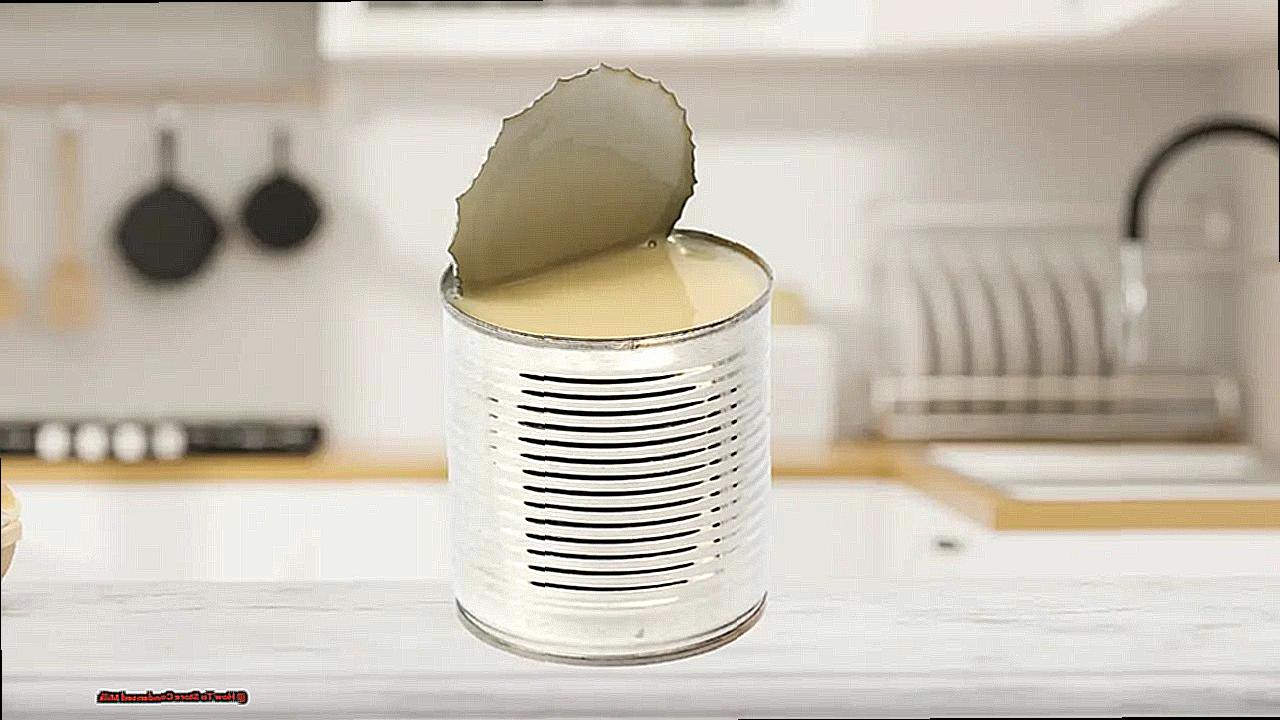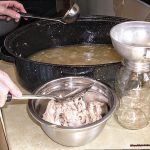Do you have a sweet tooth that craves the rich and creamy goodness of condensed milk? Whether you use it for baking, adding a touch of sweetness to your coffee, or simply indulging in a spoonful straight from the can (we won’t judge), proper storage is key to maintaining its deliciousness.
In this blog post, we’ll share expert tips on how to store condensed milk to keep it fresh and tasty for all your culinary endeavors. Say goodbye to spoiled cans and hello to perfectly preserved condensed milk with these simple yet effective methods:
- The importance of refrigerating opened cans
- How freezing can extend the shelf life of condensed milk
- Creative ways to store leftover condensed milk
- The role of air-tight containers in preserving freshness
- Tips for preventing crystallization and separation
Whether you’re stocking up on condensed milk for your next baking project or looking for ways to make it last longer, this guide has got you covered. So let’s dive in and discover how to keep our beloved condensed milk at its best.
Contents
How To Store Condensed Milk?
When it comes to storing condensed milk, there are three main methods to ensure its safety and freshness: in the fridge, freezer, or at room temperature in a cool, dry place. The table below summarizes these storage methods and their recommended shelf life.
| Storage Method | Shelf Life |
| In the refrigerator | Up to 2 weeks (unopened) 5 days (opened) |
| In the freezer | Up to 6 months |
| At room temperature | Up to 2 years (unopened) |
If you have an unopened can of shelf-stable condensed milk, it can last up to two years past the expiration date when stored in a cool, dry place. However, once opened, it should be transferred to an airtight container and kept in the fridge for up to seven days.
On the other hand, refrigerated condensed milk should always be stored in the refrigerator and consumed within five days after opening.
Another crucial aspect of storing condensed milk is keeping it away from direct sunlight, heat sources, and moisture. Exposure to these elements can alter its texture and taste, making it unsafe for consumption. Additionally, using clean utensils when handling condensed milk is essential to prevent contamination.
For a longer shelf life, you can also freeze condensed milk. It is recommended to transfer it into an airtight container or freezer-safe bag before placing it in the freezer. Frozen condensed milk can last up to six months and should be thawed in the fridge before use.
In conclusion, proper storage plays a vital role in maintaining the safety and freshness of condensed milk. Whether it is shelf-stable or refrigerated, always check the expiration date and handle it with clean utensils.
Can You Freeze Condensed Milk?
and the answer is yes. In fact, freezing this sweet and creamy ingredient can actually extend its shelf life by a few months. However, there are some essential factors to consider when storing condensed milk in the freezer.
First and foremost, it’s important to use an airtight container for freezing condensed milk. This will prevent freezer burn and maintain its delicious taste and texture. Additionally, leaving some room for expansion during freezing is crucial to avoiding any mishaps.
If you want to ensure optimal results, consider using a freezer-safe container specifically designed for liquids. These containers have an airtight seal and can withstand freezing temperatures.
But why freeze condensed milk in the first place? Well, while its high sugar content acts as a natural preservative, freezing can still be a great option for storing it for an extended period without affecting taste or texture.
So, how long can you freeze condensed milk? It can last for several months if properly stored and sealed. However, it is best to use it within 3-4 months for optimal quality and taste.
When it’s time to thaw your frozen condensed milk, simply place the container in the fridge overnight and let it thaw slowly. This will help maintain its deliciousness.
How To Defrost Condensed Milk
The most highly recommended method for defrosting condensed milk to guarantee its suitability for consumption is gradually thawing it in the refrigerator. This effectively prevents any bacterial growth and maintains a safe temperature throughout the entire process.
While other methods, such as using cold water or the microwave, can also be employed, extra caution must be taken to avoid prolonged exposure to warm temperatures.
It should be noted that once condensed milk has been thawed, it is not advisable to refreeze it. Proper storage of condensed milk is also critical in ensuring its safety, which includes keeping it refrigerated if opened and away from any sources of heat. By adhering to these guidelines, you can safely defrost and utilize your condensed milk without any worries.
To defrost condensed milk, there are various methods that can be used. However, the recommended approach is to thaw it gradually in the refrigerator. This will effectively prevent any bacterial growth and maintain a safe temperature throughout the process. Other methods, such as using cold water or the microwave, can also be used but with extra care taken to prevent exposure to warm temperatures for an extended period of time.

It is essential to note that once condensed milk has been thawed, it should not be refrozen. Doing so may compromise its safety and quality. Therefore, it is crucial to properly store condensed milk to ensure its freshness and safety.
This includes storing it in the refrigerator if opened and keeping it away from any sources of heat.
How Long Does Condensed Milk Last?
Condensed milk is a well-liked ingredient in many recipes and can be a great addition to any pantry. However, like all food products, it does have an expiration date. The recommended shelf life of condensed milk varies depending on the brand, but generally, it can last up to two years if unopened.
There are various factors that can influence the expiration date of condensed milk, such as storage conditions and whether the can has been opened or not. It is crucial to store unopened cans in a cool, dry place away from direct sunlight and heat sources. Exposure to heat or sunlight can cause condensed milk to spoil quicker and lose its freshness.
Once opened, condensed milk should be promptly refrigerated and tightly covered with plastic wrap or a lid. This will help prevent bacterial growth and maintain its freshness. Sweetened condensed milk that has been continuously refrigerated can last for approximately 5 to 6 days. If you open the can and store it in the fridge, it will remain fresh for a maximum of two weeks.
The recommended shelf life of condensed milk is at least two years if unopened and properly stored. However, after opening, it should be consumed within 5-6 days if continuously refrigerated or within two weeks if opened and stored in the fridge.
How To Know When Condensed Milk Is Rancid?
When it comes to determining if condensed milk has spoiled and is no longer fit for consumption, there are several key signs to keep an eye out for:
Changes in appearance and texture
Any unusual color changes, such as a brown or gray hue, or a lumpy and clumpy texture, are strong indicators that the condensed milk has gone bad.
Foul odor
A funky or unpleasant smell is a clear indication that the condensed milk has spoiled.
Visible mold growth
If you spot any mold on the surface of the condensed milk, or see black or green spots that do not have a sour smell, it’s best to avoid consuming it.
Off taste
A sour or musty taste is a telltale sign that the condensed milk has gone bad and should not be consumed.
Difficult to pour
If the condensed milk has become too thick and cannot be poured, it is likely spoiled and should not be consumed.
Suspicion
If there are no visible changes in appearance or smell, but you still have doubts about its freshness, you can try tasting a small amount to confirm.
If any of these signs are present, it is best to discard the condensed milk to avoid any potential foodborne illnesses. Properly storing and handling condensed milk can help prevent it from spoiling before its expiration date and ensure its safety for consumption.
How To Defrost Condensed Milk
One of the most reliable ways to safely defrost condensed milk is by letting it thaw in the refrigerator overnight. Here’s how to do it:
Move the frozen condensed milk from the freezer to your refrigerator. If you have your condensed milk stored in an airtight container or a freezer-safe bag, place it in the fridge the night before you intend to use it. This will ensure that it thaws slowly and evenly.
Stir well before using. Once thawed, make sure to mix the condensed milk properly before using it in any recipe. This will guarantee consistent texture and consistency throughout.
Do not refreeze thawed condensed milk. Once you have thawed your condensed milk, avoid refreezing it as this can affect its quality and safety.
If you need to use condensed milk quickly, you can also thaw it by placing the sealed container or bag in a bowl of cold water for around 30 minutes. Remember to change the water every 10 minutes to keep it chilled. However, this method is not recommended as it can result in uneven thawing and increase the risk of bacterial growth.
Another option is to use the defrost function on your microwave. However, this should only be used as a last resort and with caution. Microwaving can cause uneven heating, which can pose potential food safety risks.
In a nutshell, the best and safest way to defrost condensed milk is by letting it thaw in the refrigerator overnight. This ensures even thawing and maintains the quality and safety of the product.
How Long Does Condensed Milk Last?
The duration of time that condensed milk can last is determined by its form, whether it is from a can or made at home, and how it is kept. Sealed cans of condensed milk can remain edible for up to 18 months, while open cans and homemade condensed milk should be consumed within one week. Appropriate storage in a cool and dry area is essential for prolonging the shelf life of condensed milk.
When considering the various types of condensed milk, there are several factors that can affect their longevity. For example, canned condensed milk has a longer shelf life compared to homemade versions. Additionally, the way in which it is stored also plays a significant role in how long it will last. Keeping condensed milk in a cool and dry place will help to maintain its quality for a longer period of time.
Moreover, it is important to note that once opened, condensed milk should be consumed within one week to ensure its freshness and taste. This applies to both canned and homemade versions. Neglecting to consume it within this timeframe may result in spoilage and potential health risks.
To ensure that your condensed milk stays fresh for as long as possible, proper storage is crucial. Keep it in a cool and dry place away from direct sunlight or heat sources, such as the stove.
How To Know When Condensed Milk Is Rancid?
When you’re wondering if condensed milk is still okay to eat, there are several signs to look out for. Follow these easy steps to find out:
Look for changes in color and texture
Ideally, condensed milk should be a pale yellow color and have a smooth, creamy texture. If it appears darker or has clumps, it’s a sign that it’s gone bad.
Give it a sniff
Take a whiff of the condensed milk to check for any odd or sour smells. If it has a strange or unpleasant scent, this is a clear indication that it has spoiled.
Taste a little bit
If the smell doesn’t give it away, you can also taste a small amount of the condensed milk to see if the flavor has changed. If it tastes sour or off, then it’s no longer safe to eat.
Check for mold
If you see any mold on the surface of the condensed milk or black/green spots, this is a definite sign that it has gone bad and should be thrown away.
Expiration date
Always check the expiration date on the package before using condensed milk. If it’s already past the date, discard it and get a fresh container.
Conclusion
In conclusion, proper storage is key to preserving the deliciousness of condensed milk.
Whether you use it for baking, adding sweetness to your coffee, or enjoying it straight from the can, implementing these expert tips will ensure that your condensed milk remains fresh and flavorful. From refrigerating opened cans to freezing for extended shelf life, there are various methods to maintain this sweet and creamy ingredient at its peak.
By following these simple yet effective techniques, you can bid farewell to spoiled cans and greet perfectly preserved condensed milk.




